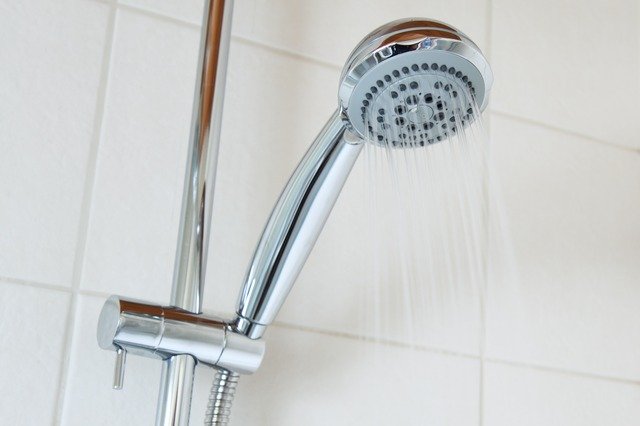Ever stepped into the shower for a nice, relaxing moment… only to be greeted by gross black spots creeping along the bottom of your curtain? Yep, I’ve been there too. It’s mold—and it’s not just ugly, it makes your whole bathroom feel icky and not-so-clean.
But don’t worry, you don’t need to grab a mask and heavy-duty chemicals to deal with it. You probably already have the perfect mold-fighting hero in your kitchen: white vinegar.
Let’s talk about why mold loves your shower curtain so much, how vinegar helps, and exactly how you can use it to kick that mold to the curb—without any harsh chemicals.
Table of Contents
Why Does Mold Keep Showing Up on My Shower Curtain?
Okay, let’s get real. Mold loves bathrooms, especially the shower. Why? Because it’s warm, wet, and steamy—basically paradise for mold spores.
When water sits on your shower curtain (especially at the bottom where it might bunch up or touch the tub), and the air doesn’t dry it out quickly, mold starts moving in. Add in a bit of leftover soap, shampoo, or body oil and boom—you’ve created the perfect all-you-can-eat buffet for mold and mildew.
And no, it doesn’t matter if your curtain is plastic, vinyl, or fabric. Mold isn’t picky—it’ll grow on whatever it can!
Why I Use Vinegar (and Why You Might Want to Too)
You could grab a bottle of bleach or some industrial-strength cleaner. But if you’re like me, you’d rather not breathe in harsh fumes every time you clean your bathroom—especially in a small, closed space like the shower.
Here’s why I prefer vinegar:
- It’s natural – No scary chemicals.
- It’s safe – I don’t have to worry about it irritating my skin or harming pets.
- It’s cheap – A big bottle costs just a few bucks.
- It actually works – The acetic acid in vinegar helps kill mold and bacteria, break down soap scum, and remove odors.
Pretty awesome for something that also goes on your salad, right?
How Vinegar Fights Mold
So, how does this simple liquid battle something as nasty as mold?
It’s all thanks to acetic acid, the main ingredient in white vinegar. Acetic acid:
- Kills many types of mold and mildew
- Cuts through soap scum (which mold loves to hide under)
- Helps deodorize those musty, gross smells
Now, let’s walk through how to use vinegar to clean that moldy curtain—two easy methods depending on what kind of curtain you have and how bad the mold is.
Method 1: Toss It in the Washing Machine
Best for: Fabric curtains or washable plastic liners
What You’ll Need:
- Moldy shower curtain or liner
- White distilled vinegar
- Regular laundry detergent
- Optional: ½ cup baking soda
- Optional: 1–2 old towels
Steps:
- Take it down: Unhook your curtain or liner. Check the label to make sure it’s machine washable.
- Load it up: Put it in the washing machine with a couple of old towels. These help scrub the curtain gently as it washes.
- Add your cleaners:
- Use your regular detergent
- Add 1–2 cups of vinegar (either in the fabric softener spot or straight into the drum)
- Toss in baking soda if you want a little extra stain-fighting power
- Choose the right settings: Use warm or hot water if your curtain can handle it (hot water kills more mold spores).
- Run the cycle: Let the machine do the dirty work.
- Air dry it: This part’s super important. Hang your curtain back up fully stretched out and let it air dry completely. Don’t stick it in the dryer—it could melt or warp!
Method 2: Soak or Spot Clean
Best for: Plastic liners, delicate fabrics, or stubborn moldy spots
What You’ll Need:
- White vinegar
- Warm water
- Spray bottle or bucket
- Soft brush or sponge
- Optional: Baking soda
Steps:
- Mix your solution: Combine equal parts vinegar and warm water in a spray bottle. For tough mold, use full-strength vinegar.
- Spray it on: Spray the moldy areas until fully soaked. Or soak the whole curtain in a bucket or bathtub with vinegar and water.
- Let it sit: Let the vinegar do its magic for 15–60 minutes depending on how bad the mold is.
- Scrub it: Gently scrub with a sponge or soft brush. Use a baking soda paste (baking soda + water) on stubborn spots for extra cleaning power.
- Rinse well: Use clean water to rinse off everything thoroughly.
- Hang to dry: Again, this part is key. Hang it back up and make sure it’s stretched out so it dries fast and evenly.
Want an Extra Cleaning Boost? Try These Natural Add-Ons
Vinegar is amazing on its own, but if you want to step it up a notch, here are a few natural helpers:
- Baking Soda – Gentle scrubber and odor-fighter
- Tea Tree Oil – Natural antifungal. Add 10–20 drops to your spray bottle for a powerful punch
- Lemon Juice – Fresh scent, mild cleaner (great for light spots)
Just don’t mix vinegar with bleach—that combo creates toxic gas. Stick to safe combos like vinegar + baking soda or vinegar + tea tree oil.
Tips to Prevent Mold from Coming Back
Once you’ve cleaned your curtain, let’s keep it clean! Here are my top tips to stop mold from coming back:
- Use that bathroom fan! Run it during and after your shower for at least 15–20 minutes.
- Stretch the curtain out – Don’t leave it bunched up. Air needs to flow to dry it.
- Wipe it down – A quick towel swipe at the bottom after showers makes a big difference.
- Tuck it in – Keep the bottom of your liner inside the tub so water doesn’t pool on it.
- Use a mold-resistant liner – These are designed to resist mold and mildew (you can find plenty on Amazon!).
- Do a quick spray every week – Keep a vinegar spray bottle nearby and give the bottom of the curtain a little mist every few days.
When It’s Time to Toss the Curtain
Sometimes, even vinegar can’t save a shower curtain. If you’ve tried cleaning and it’s still stained, smelly, or falling apart, it might be time to replace it. Look for:
- Permanent stains that won’t come out
- A lingering mildew smell
- Rips, cracks, or worn-out grommets
- Mold that comes right back even after cleaning
Don’t feel bad—shower curtains don’t last forever! Grab a new one (maybe even a mold-resistant one this time) and keep up with easy maintenance to make it last longer.
FAQs About Cleaning with Vinegar
Q: What kind of vinegar should I use?
A: Use plain white distilled vinegar—about 5% acidity. Skip the fancy stuff like apple cider vinegar for this job.
Q: Will my bathroom smell like vinegar?
A: For a little while, yes. But once it dries and you rinse it well, the smell disappears.
Q: Is vinegar safe for all curtain types?
A: Usually, yes! But test a small hidden spot first, especially if your curtain is made from decorative or special materials.
Q: Can I mix vinegar with bleach to make it stronger?
A: Absolutely not. That combo creates toxic chlorine gas—super dangerous. Never mix the two.
Q: How often should I clean my curtain?
A: Light spray once a week and deep clean every 1–3 months is a good rule. More often if your bathroom stays humid.
The Bottom Line
Cleaning mold off your shower curtain naturally with vinegar is super simple, safe, and satisfying. It’s cheap, easy to do, and better for your lungs and the environment than harsh chemicals.
So the next time you see those creepy black spots creeping in, don’t panic—just grab the vinegar. With a few smart habits and a little routine care, you’ll keep your bathroom fresher, cleaner, and mold-free.
Got a moldy curtain right now? Try one of these methods today and let me know how it goes—I’d love to hear what worked for you!
Would you like me to format this with product links and shortcodes for your blog?






